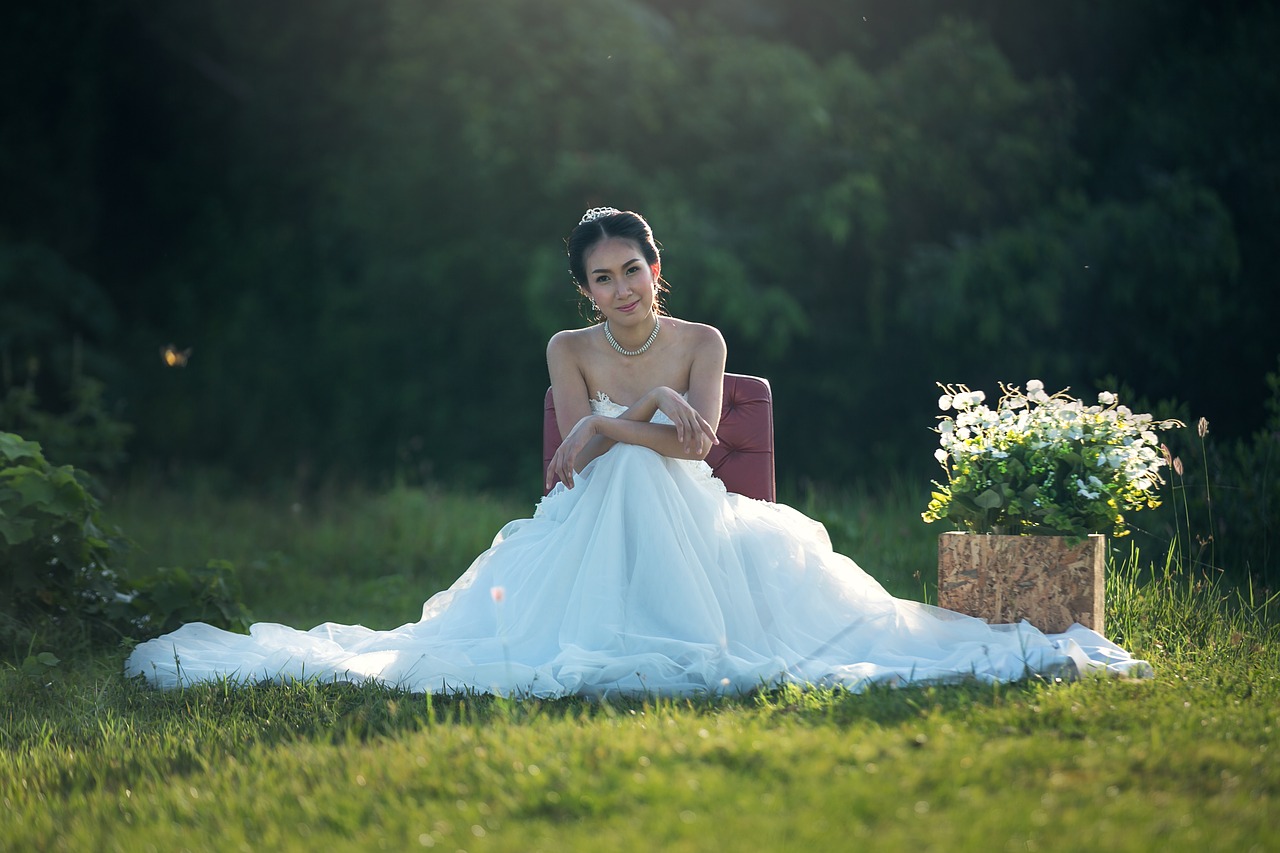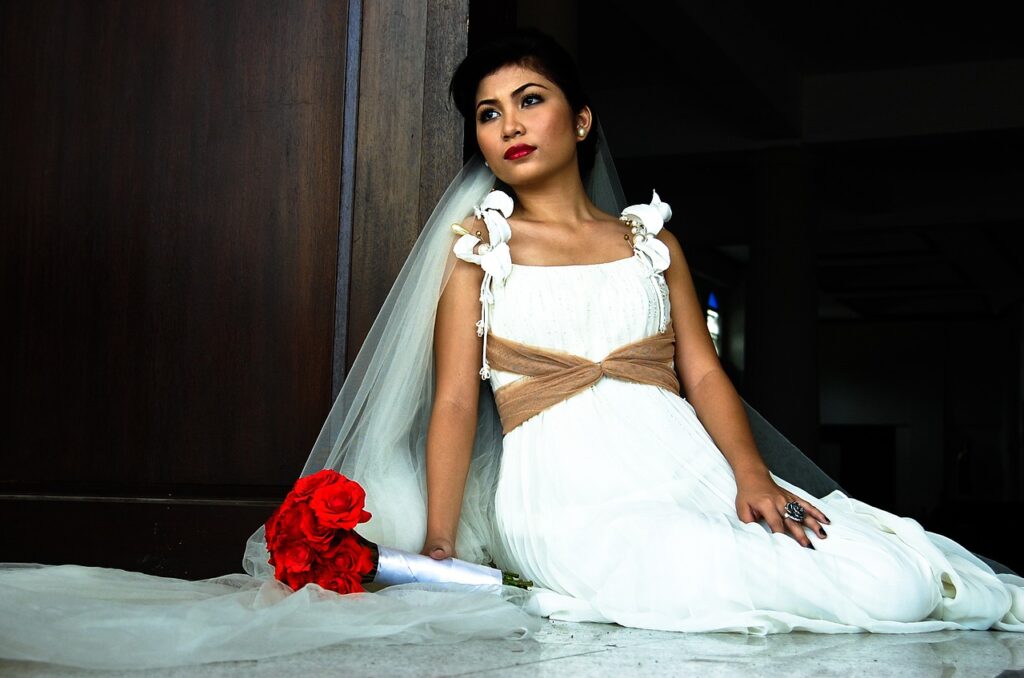Selecting your dream wedding dress is a major step, but ensuring it fits perfectly involves wedding dress alterations—a process that adjusts the gown to suit your body, style, and movement needs for your wedding day.
Wedding dress alterations encompass everything from basic size adjustments to complex customisations like changing the neckline, adding embellishments, or creating a bustle for the train.
This guide will cover what wedding alterations entail, the essential steps in the process, and tips for choosing a skilled sewist.
Let's get straight to the point
Getting your wedding dress to fit perfectly involves adjusting the bust, waist, and hemline, adding sleeves or bustle, and customising details to match your style. Start with an initial consultation, followed by two or three fittings to refine the fit.
Choose a skilled sewist with bridal experience, and always bring your wedding shoes and undergarments to each fitting. Plan a perfect final fitting close to the wedding day for a perfect finish.
Focus on essential adjustments to balance quality and budget, ensuring a flawless, personalised fit.
What Is A Wedding Dress Alteration?

Wedding dress alterations are custom adjustments made to a wedding gown to ensure it fits the bride perfectly. Wedding dresses are typically purchased in standard sizes, so alterations are often necessary to achieve the ideal fit and comfort. Wedding alterations might include:
- Adjusting the Bust, Waist, and Hips: Tailoring the dress to your specific measurements to fit closely and comfortably.
- Shortening or Lengthening the Hemline: Ensuring the dress falls at the perfect length, especially if heels are involved.
- Adding or Modifying Sleeves and Straps: Customising sleeve length or strap tightness for added comfort and style.
- Creating a Bustle: Adding a mechanism to lift the train for reception allows you to move freely.
- Enhancing or Removing Embellishments: You can add lace, beading, or other embellishments or remove details to match your style.
- Reshaping the Neckline: Changing the neckline to complement your body shape or create a unique look.
Steps In The Wedding Dress Alteration Process
Wedding dress alterations are usually spread across several appointments to ensure the perfect fit. Here’s a breakdown of each step involved:
Step 1: Initial Consultation
This is your first meeting with the seamstress, typically 8-10 weeks before the wedding. During this appointment:
- Discuss Your Vision: Explain any specific ideas you have for the dress, such as neckline changes or added embellishments.
- Initial Fitting: The seamstress will take measurements to understand the scope of the required alterations.
- Get an Estimate: The tailor will estimate the cost for the alterations based on the work involved.
Step 2: First Fitting
This fitting occurs after the initial adjustments have been made. It focuses on basic alterations like hemming and taking in the sides. During this fitting:
- Adjust the Hemline: Ensures the dress length matches your height, especially with shoes on.
- Take in or Let Out Sides: The dress is adjusted to fit snugly at the waist and bust.
- Assess Sleeve or Strap Fit: Sleeves and straps are modified for comfort and support.
Step 3: Second Fitting
In the second fitting, refinements are made to fine-tune the adjustments from the first fitting. This is a time to:
- Confirm Overall Fit: Ensure the dress fits closely but comfortably.
- Adjust Embellishments: Any additional beading, lace, or details are added as discussed.
Step 4: Final Fitting
The final fitting is scheduled a week or two before the wedding to make last-minute tweaks. Here, you can:
- Finalise Any Minor Adjustments: Ensure all seams are in place and the fit is perfect.
- Test Movement: Walk, sit, and dance in the dress to confirm comfort.
Tips For Choosing A Seamstress For Wedding Dress Alterations
Selecting the right seamstress is essential for a successful alteration experience. Here are some tips to help you choose:
- Look for Experience in Bridal Dresses
Not all sewists specialise in bridal wear. Look for someone who has experience working with wedding gowns and is familiar with delicate fabrics like lace, chiffon, and satin. - Review Their Portfolio
Ask to see before-and-after photos of previous work. This helps you gauge their skill in handling complex alterations like beading or lacework. - Seek Recommendations
Ask for referrals from friends, family, or wedding vendors, and read online reviews. Sites like Yelp or Google Reviews can offer insights into the sewist’s reputation and reliability. - Evaluate Communication Skills
A skilled sewist will listen carefully to your requests and provide honest feedback about what is possible. Clear communication helps avoid misunderstandings and ensures your vision aligns with what is feasible. - Get a Cost Estimate
Request a cost estimate upfront, understanding that complex alterations will be more expensive. This helps you budget accordingly and avoid surprises.
Essential Tips For Wedding Dress Alterations

To ensure a smooth alteration process and a flawless fit, keep these tips in mind:
- Purchase a Slightly Large Dress
It’s easier to take a dress in than to let it out. Buying a slightly too big dress provides more options for achieving a tailored fit. - Bring Your Wedding Shoes and Undergarments to Each Fitting
Wearing the shoes and undergarments you’ll have on your wedding day helps the seamstress adjust the dress to match your final look. - Limit Major Silhouette Changes
Dresses are designed with a certain silhouette in mind. Making drastic changes to this shape can be challenging and costly. - Plan for Final Adjustments Close to the Wedding Date
Weight fluctuations are common in the lead-up to the wedding. Scheduling a final fitting close to the wedding ensures a precise fit. - Consider Fabric Limitations
Delicate fabrics like lace or chiffon require extra care. Discuss any fabric limitations with your seamstress to set realistic expectations.
Common Wedding Dress Alterations And Costs In Australia
Certain alterations are more common in wedding gowns than others. Here’s an overview of typical adjustments and what they involve in terms of Australian costs:
- Hemming adjusts the dress length. Depending on the fabric and dress style, the cost can range from AUD 150 to AUD 600.
- Taking in the Bodice: This ensures a snug fit around the waist and bust, and prices range from AUD 200 to AUD 400.
- Adding a Bustle: Essential for dresses with a train, with costs from AUD 80 to AUD 200.
- Adjusting Straps or Sleeves: Modifies straps for better comfort and fit, costing AUD 100 to AUD 300.
- Adding Beading or Embellishments: Custom embellishments may add between AUD 250 and AUD 600 to the total cost.
Questions To Ask Your Wedding Dress Seamstress
To ensure your dress is in capable hands, consider asking these questions before committing to a sewist:
- What is Your Experience with Wedding Dresses?
Verify their background to ensure they are skilled with bridal gowns, especially if your dress has intricate detailing. - Do You Have Before-and-After Photos?
Many sewists keep portfolios. Reviewing photos of their previous work can help you gauge their experience. - How Many Fittings Will I Need?
Understanding the timeline for fittings helps you manage your schedule and avoid last-minute stress. - Can You Provide an Estimate?
An initial cost estimate helps set budget expectations and minimises surprises. - What Are Your Policies on Last-Minute Adjustments?
Unexpected tweaks may be needed. Ensure they can accommodate last-minute adjustments, especially if weight or body shape changes.
Managing The Alteration Timeline
Creating a timeline for your wedding dress alterations can help reduce last-minute stress. Follow this guideline:
- Purchase Your Dress Early: Aim to buy the dress 8-12 months before the wedding to allow ample time for alterations.
- Schedule the Initial Consultation: Book this 8-10 weeks before the wedding to establish the scope of the alterations.
- Plan Fittings Every 2-3 Weeks: Based on the complexity of the work, allow time for follow-up fittings.
- Final Fitting 1-2 Weeks Before the Wedding: Schedule a last fitting to ensure the dress fits perfectly.
Balancing Budget And Quality In Dress Alterations

Balancing quality and budget can be challenging with wedding dress alterations. To manage costs effectively:
- Prioritise Essential Alterations: Focus on fit adjustments first, then consider embellishments or customisation if budget allows.
- Opt for Skilled, Not Cheap: Choosing a highly rated sewist, even if pricier, reduces the risk of errors.
- Plan for Final Adjustments: Small tweaks close to the wedding may add to the cost but ensure a perfect fit.
Conclusion
Wedding dress alterations are vital in transforming a beautiful gown into a perfect fit for your special day.
By understanding the types of alterations, navigating the fitting process, and carefully choosing a skilled sewist, you can achieve a flawless, custom look that aligns with your style and comfort needs.
Factor in essential tips like purchasing slightly large, bringing wedding shoes and undergarments to each fitting, and planning final adjustments close to the wedding.
With a clear timeline and focus on quality and budget, your wedding dress alterations will ensure you feel confident, comfortable, and truly yourself as you walk down the aisle.

